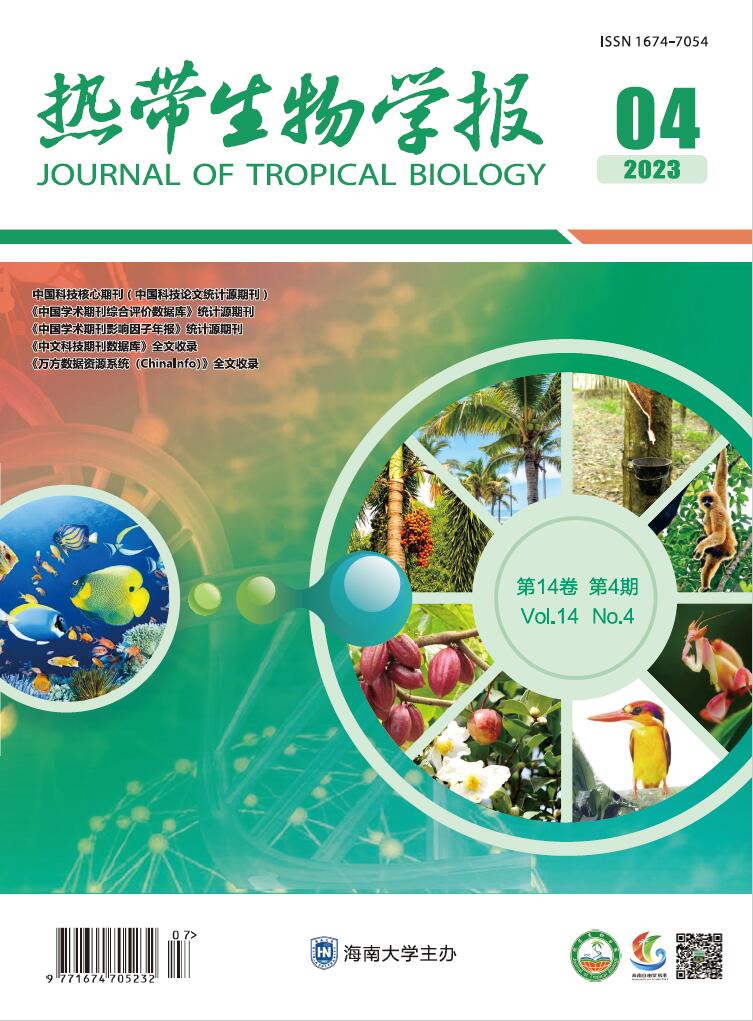-
火龙果(Hylocereus polyrhizus)属仙人掌科(Cactaceae)多年生攀援性植物,原产于热带及亚热带美洲地区[1]。目前,我国广西、广东、海南和台湾等地均有种植。火龙果果实富含水溶性膳食纤维,维生素C,花青素等营养成分,具有极高的保健和商业价值[2-4]。果实在生长发育期间需要提供足够的养分以保证果实的正常生长发育[5-6],李兴忠等研究认为,不同氮、磷、钾肥的配施水平均可显著提高火龙果的产量[7],但目前关于火龙果的施肥研究不多。随着栽培技术的改进,火龙果种植模式由传统的“单柱式”逐渐向“排式”转变,施肥方式向水肥一体化转变。为此,笔者以2年生排式种植的火龙果为材料,研究了滴灌条件下不同氮素水平对火龙果果实生长及品质的影响,旨在为火龙果生殖生长阶段的合理施肥提供理论依据。
-
红肉火龙果品种为台湾‘软枝大红’。
-
试验地位于广西崇左市江州区那隆镇(E107.57°,N22.72°),海拔140 m,属亚热带季风气候。基地建于2017年5月,面积15 hm2,种植密度11 400株·hm−2,年日照可达1 600 h,年平均气温22.3 ℃,年均降雨量1 200 mm,全年无霜期364 d。试验地土壤为赤红土壤,pH5.35,耕层土壤(0~20 cm)含全氮740 mg·kg−1、有效磷140 mg·kg−1、速效钾350 mg·kg−1、有机质12.54 g·kg−1。
-
在磷肥(170 kg·hm−2)和钾肥(580 kg·hm−2)不变的基础上设置5个氮肥(纯氮)水平:0(T0),315 kg·hm−2(T1),450 kg·hm−2(T2),585 kg·hm−2(T3),800 kg·hm−2(T4)。每个处理设置4次重复,共20个小区,随机区组排列。选择地势平缓、整齐、肥力差异较小的地块作为火龙果试验用地,采用“单排”式栽培模式,每个小区含有2条滴带,滴孔间距15 cm,铺设在火龙果苗两侧,距离火龙果苗5 cm。相邻小区行距2.5 m,苗株距20 cm。试验用的氮肥为尿素(阳煤丰喜肥业有限公司生产,N≥46.4%),磷肥为久久磷钾(深圳市富威特植物营养有限公司生产,P2O5≥51%),钾肥为速溶硫酸钾(深圳市德华肥料有限公司代理,K2O≥51%)和久久磷钾(深圳市富威特植物营养有限公司生产,K2O≥34%)。除施氮量不同外,其他田间管理均与常规管理相同。每月施肥6次,平均每5天施肥1次。
-
火龙果花于2018−05−19上午9:00~10:00取样。每个处理选取9朵火龙果花,样品采集后用干净的湿纱布擦去花朵外表面的灰尘,然后将花放置于档案袋中,于105 ℃温度下杀青30 min,再调至85 ℃至完全烘干,然后粉碎保存在密封袋中,做标记,用于测量火龙果花氮磷钾含量。
果实采样时间分别为2018−07−05和2018−09−05上午9:00~10:00。每个处理选取9个果实,样品采集后先用清水清洗,再用去离子水冲洗2~3遍,置于4 ℃冰箱中进行预冷处理,然后将样品送到实验室进行品质分析。取部分新鲜火龙果果肉置于铝盒中,先于105 ℃温度下杀青30 min,再调至85 ℃至完全烘干,然后粉碎保存在密封袋中,做标记,用于测量果实氮磷钾含量。
-
选择各小区内所有火龙果果实观察测量果实生长(2018−09−23—10−26),每3天观察测量1次,共计12次,33 d。测量方法:用游标卡尺测量果实基部到顶端的距离,记为果实纵径;用游标卡尺测量果实中心部的宽度,记为果实横径。果形指数=果实纵径/果实横径。
-
在果实采收时,每小区选择3个果实,每个处理9个果实,分析果实可溶性固形物、可溶性糖和抗坏血酸及果实有机酸含量。其中,可溶性固形物含量采用折射仪法测定;可溶性糖含量采用蒽酮−乙酸乙酯法测定;抗坏血酸含量分光光度计法测定;有机酸含量采用酸碱滴定法测定[8]。
-
样品全氮含量采用H2SO4-H2O2消煮−纳氏比色法测定;样品全磷含量采用H2SO4-H2O2消煮−钼锑抗比色法测定;样品全钾含量采用H2SO4-H2O2消煮−火焰光度法测定[9]。
-
数据分析用Excel和SPSS 20.0 进行,利用方差分析检验不同氮素处理下火龙果果实矿质养分含量及品质之间的差异性。
-
由图1可知,火龙果花谢后到果实成熟前,不同氮肥用量下火龙果果实的纵径和横径的差异逐渐增大。由图1a,b可知,在花后6 d时,各处理果实纵径和横径差异较小。随着果实生育期的延长,氮肥用量对果实纵径和横径的影响逐渐显现出来。果实生长末期,随着氮肥用量的增加,果实纵径和横径均呈现出先增加后降低的趋势,且T2处理果实纵径和横径均达最大值,分别为104.99,93.05 mm,分别较T0处理提高了10.18%和4.67%。
不同处理间火龙果果形指数变化相似,均逐渐变小。如图1c所示,花后6 d时,T0,T1,T2,T3和T4处理果形指数分别为1.19,1.21,1.20,1.20和1.20,但各处理间火龙果果形指数差异不显著。在果实生长发育过程中,果实横径的生长速率高于纵径,成熟时各处理火龙果果形指数分别为1.07,1.11,1.13,1.10和1.06,但各处理间差异不显著,果实近似圆形。
-
由表1可以看出,不同氮素水平下火龙果花中氮磷钾含量存在较大差异。随着氮素水平的增加,各处理火龙果花中氮磷含量均呈现出先增加后降低的趋势。其中T3火龙果花中氮含量达最高值为27.38 g·kg−1,T1,T2,T3和T4处理火龙果花中氮素含量均高于T0处理,分别较T0处理增加了3.67%,8.42%,10.36%和4.47%,且T1,T2和T3处理均显著高于T0处理;T1处理火龙果花中磷含量达最高值为4.38 g·kg−1,较T0处理增加了10.89%,且显著高于其他处理,而T2处理与T0处理差异不显著,其余处理则低于T0处理。T1和T3处理火龙果花中全钾含量均高于T0处理,分别较T0处理增加了7.55%和3.76%,而其余处理则低于T0处理。不同处理火龙果花中氮磷钾含量存在差异,而同一处理火龙果花中氮磷钾含量也存在差异,从表1可知,各处理火龙果花中氮磷钾含量均依次为K>N>P。
处理 Treatment N/(g·kg−1) P/(g·kg−1) K/(g·kg−1) T0(0 kg·hm−2) 24.81±0.54c 3.95±0.04b 54.80±1.41ab T1(315 kg·hm−2) 25.72±0.26b 4.38±0.01a 58.94±1.13a T2(450 kg·hm−2) 26.90±0.65ab 3.99±0.09b 53.83±4.13b T3(585 kg·hm−2) 27.38±0.53a 3.66±0.03c 56.86±2.18ab T4(800 kg·hm−2) 25.92±0.84bc 3.59±0.11c 53.79±2.03b 注:表中每一栏不同的字母代表不同处理之间的差异性是否显著(P<0.05),下同。
Note: Different letters in the same column indicate significant difference between treatments(P<0.05), similarly hereinafter.Table 1. Nitrogen, phosphorus and potassium contents of flowers of pitaya treated at different nitrogen levels
-
由表2可以看出,不同氮素水平下,火龙果果实氮磷钾含量存在差异。第1次采样期,随着氮素水平的增加,各处理果实中氮素含量总体呈现出先增加后降低的趋势;T1,T2,T3和T4处理果实氮素含量均高于T0处理,且达到差异显著性水平。T1,T2,T3和T4处理果实中磷素含量均高于T0处理,其中T2和T4与T0差异显著。各处理果实中钾素含量呈现出逐渐增加的趋势,其中T4处理含量显著高于T0处理。
处理 Treatment N/(g·kg−1) P/(g·kg−1) K/(g·kg−1) T0(0 kg·hm−2) 11.16±1.15b 2.07±0.25b 13.33±0.98b T1(315 kg·hm−2) 13.50±1.26a 2.52±0.26a 14.15±0.57ab T2(450 kg·hm−2) 15.28±1.29a 2.39±0.21ab 14.39±0.72ab T3(585 kg·hm−2) 13.49±0.60a 2.25±0.05ab 14.32±0.44ab T4(800 kg·hm−2) 14.64±1.43a 2.52±0.09a 15.54±1.03a Table 2. Nitrogen, phosphorus and potassium contents of fruits of pitaya treated at different nitrogen levels in the first sampling period
由表3可知,第2次采样期,随着氮素水平的增加,火龙果果实中氮素含量呈现出逐渐增加的趋势,其中,T4处理氮素含量最高,为12.93 g·kg−1,T4,T3和T2处理均显著高于T0处理,分别较T0处理增加37.41%,27.74%,15.20%。随着氮素水平的增加,各处理果实中磷素含量呈现出先增加后降低的趋势,其中T3处理含量最高,为2.75 g·kg−1,显著高于T0处理,较T0处理增加了23.32%;T1,T2和T4处理分别较T0处理增加了5.38%,12.12%,11.21%,但T1,T2和T4处理与T0处理间无显著差异。随着氮素水平的增加,各处理果实中钾素含量呈现出先增加后降低的趋势,T1,T2,T3和T4处理中钾素含量均显著高于T0处理,分别较T0处理增加了8.10%,8.85%,10.35%和9.68%。T3处理钾素含量最高,为13.22 g·kg−1。
处理 Treatment N/(g·kg−1) P/(g·kg−1) K/(g·kg−1) T0(0 kg·hm−2) 9.41±1.12c 2.23±0.15b 11.98±0.44b T1(315 kg·hm−2) 10.22±0.12bc 2.35±0.13b 12.95±0.21a T2(450 kg·hm−2) 10.84±0.24b 2.50±0.22ab 13.04±0.16a T3(585 kg·hm−2) 12.02±0.49a 2.75±0.05a 13.22±0.06a T4(800 kg·hm−2) 12.93±0.13a 2.48±0.27ab 13.14±0.44a Table 3. Nitrogen, phosphorus and potassium contents of fruits of pitaya treated at different nitrogen levels in the second sampling period
-
不同氮素水平对各处理火龙果果实品质的影响存在差异。由表4可知,第1次采样时,随着氮素水平的增加,各处理火龙果果实中可溶性糖和抗坏血酸含量呈现出先增加后降低的趋势,且各处理间差异显著。其中,T2处理可溶性糖和抗坏血酸含量均为最高,分别为7.08%和7.93 mg·kg−1,较T0处理分别增加了65.42%和65.43%。T1处理可溶性糖含量略高于T0处理,与T0处理差异不显著,T3和T4处理则显著小于T0处理。T1处理抗坏血酸含量显著高于T0处理,较T0处理增加了40.87%,而T3和T4处理均与T0处理差异不显著。各处理果实可食率,可溶性固形物和可滴定酸含量以及果形指数均差异不显著。
处理
Treatment果实可食率
Edible rate/%可溶性固形物/%
Soluble solids可滴定酸/%
Titrable acids可溶性糖/%
Soluble sugar抗坏血酸/(mg·kg−1)
Ascorbic acid果形指数
Fruit shape indexT0 68.54±4.57a 18.56±0.10a 0.30±0.05a 4.28±0.94b 4.79±0.75c 1.28±0.05a T1 71.64±6.43a 19.11±1.69a 0.32±0.06a 4.29±0.92b 6.75±1.51b 1.31±0.08a T2 73.18±3.41a 19.16±0.82a 0.32±0.03a 7.08±1.64a 7.93±1.27a 1.29±0.04a T3 72.78±2.16a 18.41±1.06a 0.30±0.03a 2.78±2.81c 4.68±0.89c 1.30±0.06a T4 69.13±5.08a 18.11±1.17a 0.30±0.02a 2.18±1.91c 4.59±0.73c 1.34±0.08a Table 4. Quality index of pitaya fruit under treatments at different nitrogen levels in the first sampling period
由表5可知,不同氮素水平下,各处理果实可食率,可溶性固形物,可滴定酸和可溶性糖含量均存在差异性,且随着氮素用量的增加呈现出先增加后降低的趋势。T2处理果实可食率,可滴定酸和可溶性糖含量均高于T0处理,分别为66.39%,0.46%和8.26%,分别较T0处理增加了6.62%,15%和3.64%。其中,果实可食率和可滴定酸含量显著高于T0处理。T1处理果实可食率显著高于T0处理,较T0处理增加了5.51%,可溶性固形物含量,可溶性糖和抗坏血酸含量均略高于T0处理,分别较T0处理增加了2.86%,1.63%和5.19%。T3,T4处理果实可溶性糖含量则显著小于T0处理,其余品质指标则与T0处理差异不显著。各处理在抗坏血酸含量和果形指数方面差异不显著。
处理
Treatment果实可食率/%
Edible rate可溶性固形物/%
Soluble solids可滴定酸/%
Titrable acids可溶性糖/%
Soluble sugar抗坏血酸/(mg·kg−1)
Ascrobic acid果形指数
Fruit shape indexT0 62.27±2.73b 18.55±1.08ab 0.40±0.10b 7.97±1.34a 4.34±1.04a 1.11±0.03a T1 65.70±3.88a 19.08±1.15a 0.37±0.07b 8.10±1.70a 4.56±0.69a 1.08±0.04a T2 66.39±1.77a 19.07±0.61a 0.46±0.05a 8.26±4.47a 4.58±0.64a 1.11±0.05a T3 64.14±2.10ab 18.70±0.78ab 0.41±0.06b 4.74±1.95b 4.30±0.43a 1.11±0.05a T4 64.95±1.56ab 17.99±0.79b 0.41±0.05b 4.55±2.43c 4.27±0.59a 1.13±0.05a Table 5. Quality index of pitaya fruit under treatments at different nitrogen levels in the sampling period
-
本研究结果表明,施氮肥能够促进火龙果幼果的生长发育。与其他作物不同,火龙果每年可实现多批次收果,火龙果果实的生长周期在花后30~35 d。这一时期火龙果的口感最佳,营养物质含量稳定[10-11]。本研究中,花后27~32 d时,T1(低氮)处理火龙果横径显著或略高于T4(高氮)处理,说明在火龙果果实生长发育的后期,低氮条件就能够满足火龙果果实的生长需求,此时应追加高钾型肥料,从而提高果实品质。
果实中氮、磷、钾含量是决定果实品质的主要因素。王晶晶等的研究表明,适宜氮肥用量会增加红枣中氮、磷、钾的含量,但氮肥用量过多则会产生相反的效应[12];聂大杭等的研究表明,番茄果实中氮磷钾含量随施氮量增加而增加[13];张绍铃的研究表明,高氮处理条件下会导致苹果果实糖度的下降[14];李兴忠等的研究表明,氮肥用量较低时,增施钾肥能够提高火龙果果实可溶性固形物含量[7];唐恒朋等认为,高氮条件下会降低火龙果果实中可溶性总糖和抗坏血酸含量[15]。本研究中,第1采样期火龙果果实中钾含量随施氮量的增加而增加,在第2次采样期间随施氮量的增加火龙果果实中氮含量逐渐增加,磷含量则先增加后降低,钾含量呈现出先增加后降低的趋势。各处理火龙果果实中钾素含量均高于氮磷含量,说明火龙果是高钾作物,在果实生长发育期间需要吸收大量的钾元素。本研究中,随施氮量的增加,火龙果果实中可溶性固形物,可滴定酸,可溶性糖和抗坏血酸等含量均呈现出先增加后降低的趋势。
综上所述,合理控制氮肥用量能够促进火龙果果实生长发育,增加果实中氮、磷、钾含量,T2处理下火龙果果实中可溶性固形物,可溶性糖和抗坏血酸含量均达最大值,T4处理虽然果实氮磷钾含量较高,但却降低了果实品质。因此,果实生殖生长期氮肥用量以T2(450 kg·hm−2)处理较好。
Effects of Different Nitrogen Treatments on Pitaya Fruit Growth and Quality under Drip Irrigation
doi: 10.15886/j.cnki.rdswxb.2020.01.005
- Received Date: 2019-05-16
- Rev Recd Date: 2019-06-30
- Available Online: 2020-07-03
- Publish Date: 2019-11-01
-
Key words:
- pitaya /
- fruit growth /
- fruit quality /
- nitrogen fertilizer application rate
Abstract: Red-flesh pitaya (Hylocereus polyrhizus) was treated with nitrogen fertilizer at the respective levels of 0, 315, 450, 585, 800 kg·hm−2 under drip irrigation to analyze the effects of different nitrogen treatments on the growth and quality of pitaya fruit. The results showed that judicious nitrogen application rate promoted the growth of pitaya fruit, and that the amount of nitrogen needed for the fruit growth was different at the different growth stages. The amount of nitrogen applied to some extent affected the growth of fruit transverse diameter, but had little effect on the fruit longitudinal diameter. The effect of nitrogen application on the content of nitrogen and potassium in fruit increased firstly and then decreased, but there was no significant difference in nitrogen content among different treatments, but the effect of nitrogen application on phosphorus content was relatively small. The nitrogen, phosphorus and potassium contents in the fruit and flowers were in the order of K > N > P, of which the ratio of N∶K was 1∶.20∶.12 in pitaya fruit and N∶P∶K = 1.00∶0.15∶2.13 in flowers. Nitrogen fertilizer application rate had different effects on the contents of soluble solids, titrable acids, soluble sugar and ascorbic acids in fruit at different harvest stages. It is recommended that in pitaya production pitaya should be applied with nitrogen at a rate based on Treatment 2 (450 kg·hm−2) and harvest stages.
| Citation: | CHENG Yu, XU Min, XIONG Rui, LIN Jianian, RUAN Yunze, REN Taijun, ZHAO Pengfei, TANG Hua. Effects of Different Nitrogen Treatments on Pitaya Fruit Growth and Quality under Drip Irrigation[J]. Journal of Tropical Biology, 2020, 11(1): 25-30. doi: 10.15886/j.cnki.rdswxb.2020.01.005 |








 DownLoad:
DownLoad: